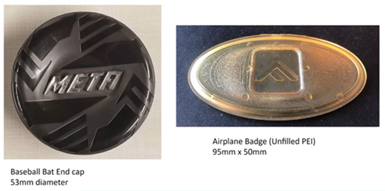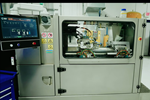3D Printed Mold Tooling Advances in Performance With Proprietary Resin
Material improvements offer turnkey production and cost trimming with 3D printed mold tooling. A new, proprietary resin addresses the current limitations associated with 3D printing in polymer.
Injection molders’ growing need for quickly produced tooling is not new; but the increasing viability of molds 3D printed in polymer is. Oftentimes, the challenge associated with traditional mold tooling is the lengthy lead time, and 3D printed molds made from polymers can offer a faster solution. However, the usefulness of currently available tooling made this way is limited. The life of the tool as measured in the quantity of molded parts it can deliver is low, and the surface finish of the printed mold may rule out producing smoother parts.
However, material improvements promise to respond to both limitations, extending the life and application range of 3D printed polymer tooling. Developments by additive manufacturing technology firm Fortify provide an example. The company makes molds by applying a proprietary resin suitable to the short-term demands of injection mold tooling. In a recent webinar, Fortify application engineer Craig Crossley, along with Ryan Lariviere, program manager for Empire Group (Fortify’s contract manufacturing partner), described some of the application possibilities they are seeing using 3D printed polymer molds.
Not All Materials Are Created Equal
Crossley says Fortify’s resin, besides being strong and rigid, offers a high heat deflection temperature (HDT). The higher the HDT, the faster the molding process will be. This feature offers increased alternatives for tooling and production at a faster pace.
Previously mentioned, the application of 3D printed polymer mold tooling is considered limited regarding quantity of parts able to be produced (as well as shelf life in some cases). Yet lead time and cost pressures challenge plastic part producers to find alternatives to conventional mold tooling. One alternative is 3D printing as a short-term bridge production method, while another solution lies in the ever-advancing material variations available for on-demand molds.
According to Crossley, Fortify is molding parts made with a range of plastics — from commodity to high performance options. These can include carbon fiber filled PEEK, liquid crystalline polymer and glass filled nylons among other materials.
The three-part selection process for 3D printing these mold tools recognizes part size, quantity and complexity as the main criteria.
Crossley says the ideal molded part size for this tooling fits into a three-inch box, as the smaller size offers optimal print time and is thus an economical way to keep costs down. While possible to print to the full size of the 3D printer’s build volume, cost and time advantages decline with greater size.

The baseball bat end cap and airplane badge offer real-life examples of the optimal size for best 3D printed results. Photo Credit: Fortify
As far as quantity goes, “Up to 200 [molded] parts is the most effective way to leverage 3D printing,” according to Crossley. This equates to no more than one single day of molding time. Cycle times per shot are currently between one and five minutes, but this is coming down thanks to experimentation with cooling methods, Crossley says.
The final component is part complexity. This factor is harder to generalize, he says. 3D printed tooling brings significant ease to obtaining complex forms to meet designers’ exact needs, but more complex features can sometimes reduce tool life.
Case Study Success
Lariviere describes the application possibilities 3D printed polymer molds afford through case study successes. One such project Lariviere details was on behalf of Keurig.
The goal of the project was to create injection molded parts for various prototypes of Keurig coffee makers. The prototypes had to meet specified requirements — withstanding boiling water and functioning on a four-week lead time. According to Lariviere, there were five variant geometric parts in total, with about 30 units of each part needed, with a three-week timeline to produce operational tooling.
“Any issues we had, if we had to print new inserts, we were able to do that overnight,” he says.
The real-time feedback from rapidly printing tools thus assisted in experimentation. If one experimental part failed, the tool for the next part design was readily available to advance further testing.

Two of the molded parts created with the assistance of 3D printed mold tools for the Keurig project. Photo Credit: Empire Group
The Finishing Touch
Postprocessing is another complication of 3D printed mold tooling that material changes have the power to address.
Traditional 3D printed mold tools often retain surface roughness as post-processing is difficult to perform on the materials currently available, Crossley says.
But the proprietary resin Fortify uses can be polished with up to an A2 finish for a smoother end-result.
This is every bit as important as the life and molded material range of the tooling, he says. For 3D printed tooling to be valuable, it needs to not only deliver parts quickly, but also deliver parts comparable in quality to conventional tools.
Related Content
VulcanForms Is Forging a New Model for Large-Scale Production (and It's More Than 3D Printing)
The MIT spinout leverages proprietary high-power laser powder bed fusion alongside machining in the context of digitized, cost-effective and “maniacally focused” production.
Read More8 Cool Parts From Formnext 2023: The Cool Parts Show #65
New additive manufacturing technologies on display at Formnext were in many cases producing notable end-use components. Here are some of the coolest parts we found at this year’s show.
Read MorePossibilities From Electroplating 3D Printed Plastic Parts
Adding layers of nickel or copper to 3D printed polymer can impart desired properties such as electrical conductivity, EMI shielding, abrasion resistance and improved strength — approaching and even exceeding 3D printed metal, according to RePliForm.
Read MoreHow Does Heat Treating Affect Machining Considerations for a Metal 3D Printed Part?
This picture of part distortion in additive manufacturing illustrates the kind of effects that part design or machining stock allowances need to anticipate.
Read MoreRead Next
Drop-In Solutions Give Users the Benefits of 3D Printed Mold Tooling
3D printed mold components, including ejector pins with venting to eliminate gas traps, can improve performance of traditional injection mold tooling.
Read MoreFrom Polymer Tooling to Metal Production Via 3D Printing
As Azoth has adopted new additive manufacturing technologies, its work has transitioned from tooling to production parts for automotive, medical and defense.
Read MoreDrones Take Flight with Metal and Polymer 3D Printed Parts: The Cool Parts Show Bonus
Drones produced by Cobra Aero now incorporate many 3D printed parts made through laser powder bed fusion and Multi Jet Fusion processes.
Read More





















